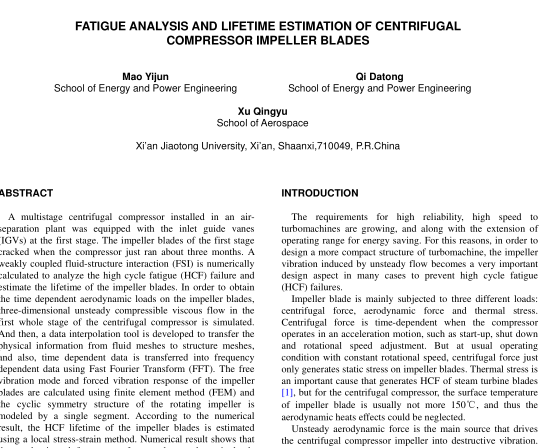ASME GT 59026:2009 pdf download FATIGUE ANALYSIS AND LIFETIME ESTIMATION OF CENTRIFUGAL COMPRESSOR IMPELLER BLADES
The impeller blades of the first stage cracked when thecompressor just ran about three months,and the fracture regionwas in the vicinity of leading edge of the impeller blades,asshown in Figure 2.There is non-obvious plastic deformation onthe broken section of the blades. Runtime is long enough toexclude the possibility of the failure due to shaft resonancevibration. Slight corrosion of purified air in two month isimpossible to crack thc bladcs.The centrifugal compressorimpeller blades don’t operate at a very high temperature,andthus aerodynamic heats effects could be neglected. The mostpossible cause is the HCF fatigue that induced by unsteadyaerodynamic forces acting on the impeller blades.
NUMERICAL MODEL
Unsteady flow simulation
Numerical calculation of the unsteady flow has beenperformed with a commercial software package, FLUENT. Thecontinuityequationand Reynolds-averagedNavier-Stokesequations (RANS) for unsteady compressible viscous flow aresolved in this work. Governing equations and standard k-epsilon turbulence model are discretized with finite volumemethod (FVM). The density-based explicit solver is adoptedfor unsteady compressible flows.The discretization scherme ofthe time-dependent term is second order. implicit. The secondorder upwind scheme is used for the convection and diffusionterms in order to eliminate the false diffusion error.
The complete flow passages modlel of first stage is adoptedfor the following two reasons. Firstly, the distorted flow at theinlet of lGvs caused by the radial induction chamber is notcircumferentially uniform. Secondly. as the numbers of thelGVs and impeller blades are relatively prime,a single flowpassage and partial flow passages moicl couldn’t reveal theiGv-impeller interaction frequency. A complete model resultsin an obvious increase of numerical complexity and runtime,sowe execute the CFD codc on a parallel platform.
A geometrical discretization of the first stage model is madefor the numerical treatment. The geometric model is dividedinto three unattached flow zones: inlet flow zone (inductionchamber and IGv). impeller zone and outlet flow zone(vaneless diffuser,crossover andreturnchannel vanes).Hybrid cells combined by unstructured tetrahedral cells andstructured hexahedral cells are generated to define the flowzones ( 1,233,074 cells at total. In the impeller, the meshesaroundthe bladesare refined to calculate the unstcadyaerodynamic loads.
Surfaces betweenIGV-impeller andimpeller-vanelessdiffuser are defined as the grid interfaces needed for thcrelative rotation of the impeller. The mixing plane approachand sliding mesh technique provided by FLUENT allowinformation transformation between upstream and downstreaminterface during the steady and unsteady flow simulation,respectively. Grid interfaces need not be matching on bothsides,as an interpolating routine is defined.
The appropriate boundary conditions are those consideredwith morephysical meaningforturbomachineryflowsimulations.that is,thetotalpressure,total temperature,turbulent intensity,turbulent viscosity ratio, and a referencepressure at the inlct boundary of the compressor are specified.In this work, since no experimental data are available for theinlet and outlet flow. It is assumed that the inlet total pressureand total temperaturc are uniform in cach grid node,bcingequal to atmosphere pressure and ambient total temperature,respectively.The turbulence intensity is assumed to be 5%,andfurthermore, the turbulent viscosity ratio is assumed to be five.At the outlet boundary of the computational domain, the flow isunsteadyand non-uniform,the target mass flow rate isspecified and the pressure at the outlet boundary is adjusted atevery iteration in order to achieve the target mass flow rate.The outlet backflow turbulent intensity is assumed to be 10%and backflow turbulent viscosity ratio is assumed to be 10.Allwall boundary conditions are regarded as no-slip and adiabaticconditions. The rigid wall boundary condition of the impellerbladcs is assumed ignoring the effect of the blade vibration totheunsteady flow,which is a reasonable approximationbecausethe stiffness isusually high for theshroudedcentrifugal impeller with short blades.
In the two grid interfaces between the stationary and movingmesh,IGv-impellerandimpeller-vaneless diffuser,theoverlapping faces in the interface zones are determined at eachnew time step. Fluxes across each grid interface are calculatedproportionally to the areas of the superposed faces.
The unsteady time step of the time-resolved CFD plays animportant role in frequency analysis.The unsteady time step is calculated with the following formula.
.t=60(n×Zz×T)
⑴
where Zz is the number of impcller bladcs. n is the rotationalspeed of impeller. T denotes the sampling number when theimpeller rotates for one flow passage, which is specified as 10.Calculated unsteady time step is 6.322 ×10*s,and thecorresponding sampling frequency is 15817.5Hz. The topfrequency of pressure fluctuation could be analyzed is about60OOHz according to the sampling theorem, which is highenough to analyze the frequency of pressure fluctuation on theblades.
The number of iterations is adjusted to reduce the residual toan acceptable value in each time step,that is to say,the ratiobetween the sum of the residuals on all grid nodes and the sumof the fluxes for a given variables,such as mass flow rate,velocity componentin three directions,turbulencekineticenergy and turbulent dissipation rate,is reduced to the value of103.Initializing the unsteady flow calculation with the steadyflow solution,over ten impeller revolutions arc necessary toachieve the periodic unsteady solution.
Free and forced vibration
Finite element analysis (FEA) is performed to obtain theimpcller bladc free vibration and forced vibration bchavior.
